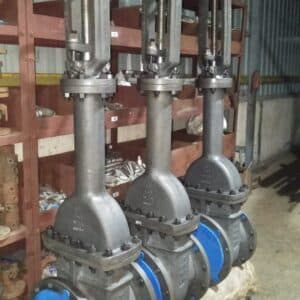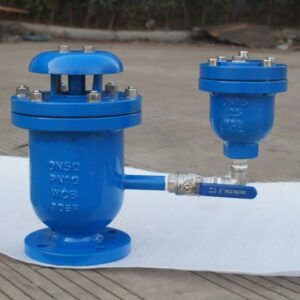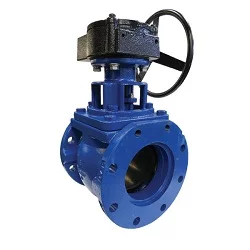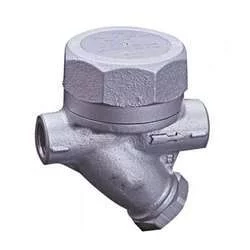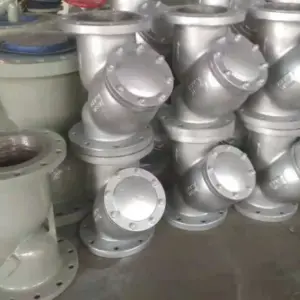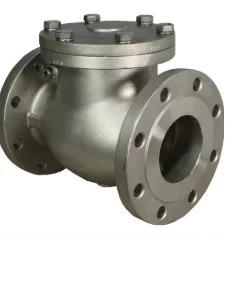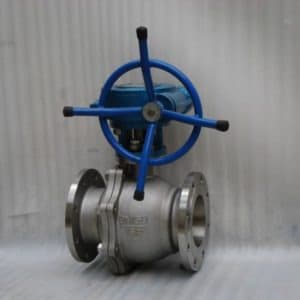The right valves are essential for flow control, pressure management, and backflow prevention in a dependable water pipeline system. We at Valvesonly provide a wide selection of high- quality water valves that are intended to improve performance, longevity, and efficiency. The most widely used valves in water pipes are broken down as follows:
A gate valve works by raising a gate (or wedge) to open the flow of fluid or closing it to shut off the flow. The gate is attached to a stem, which is translated by a handwheel or actuator. When the handwheel rotates, the stem travels upward or downward, opening or closing the gate. Gate valves cause little resistance to flow when wide open and are best for uses involving free flow and close shut-off.
Functions:
- Perfect for water pipeline on/off control.
- When fully open, it offers minimal barrier to flow.
- Ideal for subterranean water delivery systems.
- Because of the slow response, frequent operation is not advised.
To control the flow of fluids, a globe valve raises or lowers a disk or plug inside the valve body. When the valve is open, the disc’s location helps the fluid flow through the valve body. The disc stops the flow and increases pressure as it descends. The setup allows for more precise flow control and throttling. Pressure and flow rate are smoothly controlled by the rising and falling mechanism.
Functions:
- Guarantees accurate flow control.
- Works by moving a disc inside the valve up and down.
- Frequently seen in treatment facilities and water distribution networks.
- Increased pressure drops as a result of the internal flow channel layout.
A ball valve is actuated by a quarter-turn. When the handle or actuator turns the ball 90 degrees, the hole within the ball aligns with or obstructs the flow path. This effective and simple mechanism enables fast and consistent flow control. Full-bore ball valves have minimal resistance, providing maximum flow capacity, while reduced-bore ball valves have more accurate flow regulation.
Functions:
- For simple shut-off, a revolving ball with a bore is used.
- Enables a 90-degree turn and rapid operation.
- Incredibly robust and impervious to leaks.
- Frequently utilized in industrial applications and municipal water pipelines.
A butterfly valve works by turning a disc supported on a shaft in the valve body. When the valve is completely open, the disc turns in the direction of flow to permit maximum passage of fluid. When the valve is 90 degrees turned, the disc turns perpendicular to the flow and cuts off the passage and halts the flow. The rapid quarter-turn functionality makes butterfly valves extremely efficient in fluid flow control.
Functions:
- Has a revolving disc to control the flow of water.
- Lightweight, affordable, and small.
- Perfect for pipelines with a large diameter.
- Fast operation is possible, however there may be a small pressure drop.
Water can flow in only one direction through a check valve, and it prevents backflow. It automatically opens and closes under the influence of water pressure. This valve plays an essential role in avoiding contamination and ensuring the water pipe works as planned in irrigation networks and pumping houses.
Functions:
- Stops water from flowing backwards through pipelines.
- Automatically uses water pressure to function.
- Vital to irrigation systems and pumping stations.
- Available in dual-plate, swing, and lift varieties.
By reducing the incoming high pressure to a safe level, the pressure reduction valve maintains the downstream pressure constant. It is often employed in water supply systems and high-rise buildings to reduce pipeline damage caused by over-pressure, optimizing system efficiency and reducing water wastage.
Functions:
- Controls the water pressure downstream.
- Prevents excessive pressure from damaging pipelines.
- Frequently seen in water networks and tall buildings.
- Reduces water waste and boosts productivity.
The water flow is managed by the diaphragm valve through a flexible diaphragm which is lifted and lowered. Due to its high corrosion- and clogging-resistance, it is ideal for use in chemically treated water and wastewater treatment. Even under harsh conditions, its design ensures smooth functionality.
Functions:
- Use a flexible diaphragm to regulate flow.
- Resistant to clogging and corrosion.
- Perfect for chemically treated water and wastewater treatment.
- Frequently found in municipal water treatment facilities.
- Float Valve:
In reservoirs and tanks, a float valve can automatically control the level of water through opening or closing depending on the water level. Since it prevents overflows and dry running, it is an important component of storage systems. The valve requires minimal maintenance to perform effectively.
Functions:
- Regulates tank water levels automatically.
- Utilized in storage systems, overhead tanks, and reservoirs.
- Keeps overflows and dry pump operation at bay.
- Easy to use and requires little upkeep.
A needle valve employs a slender-threaded plunger that bears a resemblance to a needle for accurately controlling low-flow water usage. It is often applied in pressure gauges and metering systems where accuracy is of prime importance. But due to its minimal opening, it is unsuitable for large volume water flow.
Functions:
- Ensures that low-flow water is precisely controlled.
- Utilized in metering applications and pressure gauges.
- Ideal for systems with low flow that need precision.
- Unsuitable for transferring large amounts of water.
For your water pipeline, selecting the appropriate valve is essential for dependability, efficiency, and safety. Valvesonly offers top- grade water pipeline valves for all applications, including check valves for backflow prevention, ball valves for shut-off control, and gate valves for main pipelines.
Recent Posts
- What Is a Steam Trap and How Does It Work?
- What Is a Foot Valve and Why Is It Used in Pumping Systems?
- BI-DIRECTIONAL VS. UNI-DIRECTIONAL KNIFE GATE VALVES: WHICH ONE DO YOU NEED?
- WHAT IS A DOUBLE BLOCK AND BLEED BALL VALVE? A COMPLETE GUIDE
- UNDERSTANDING THE DIFFERENT TYPES OF AIR VALVES: SINGLE VS. DOUBLE ORIFICE

